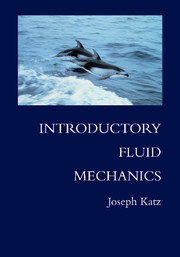Book contents
- Frontmatter
- Contents
- Preface
- A Word to the Instructor
- 1 Basic Concepts and Fluid Properties
- 2 The Fluid Dynamic Equation
- 3 Fluid Statics
- 4 Introduction to Fluid in Motion – One-Dimensional (Frictionless) Flow
- 5 Viscous Incompressible Flow: Exact Solutions
- 6 Dimensional Analysis and High-Reynolds-Number Flows
- 7 The (Laminar) Boundary Layer
- 8 High-Reynolds-Number Flow over Bodies (Incompressible)
- 9 Introduction to Computational Fluid Dynamics
- 10 Elements of Inviscid Compressible Flow
- 11 Fluid Machinery
- Appendix A Conversion Factors
- Appendix B Properties of Compressible Isentropic Flow
- Appendix C Properties of Normal Shock Flow
- Index
4 - Introduction to Fluid in Motion – One-Dimensional (Frictionless) Flow
Published online by Cambridge University Press: 05 June 2012
- Frontmatter
- Contents
- Preface
- A Word to the Instructor
- 1 Basic Concepts and Fluid Properties
- 2 The Fluid Dynamic Equation
- 3 Fluid Statics
- 4 Introduction to Fluid in Motion – One-Dimensional (Frictionless) Flow
- 5 Viscous Incompressible Flow: Exact Solutions
- 6 Dimensional Analysis and High-Reynolds-Number Flows
- 7 The (Laminar) Boundary Layer
- 8 High-Reynolds-Number Flow over Bodies (Incompressible)
- 9 Introduction to Computational Fluid Dynamics
- 10 Elements of Inviscid Compressible Flow
- 11 Fluid Machinery
- Appendix A Conversion Factors
- Appendix B Properties of Compressible Isentropic Flow
- Appendix C Properties of Normal Shock Flow
- Index
Summary
Introduction
In the previous chapter, the effects of pressure in a fluid were isolated (because the fluid was not moving) and the resulting forces were investigated. If we use the Navier–Stokes equations as a roadmap for gradually increasing the complexity of the models, then the next level requires the addition of the inertia terms in the momentum equations. For simplicity, it is assumed that the effects of viscosity are negligible, and the examples focus on cases for which such a simplification is acceptable. The addition of the viscosity term (and resulting friction) is discussed in the next chapter.
This is the first chapter in which solutions for fluid in motion are studied. By starting with the simple 1D model the basic principles can be easily demonstrated. The conservation of momentum, for example, closely resembles the classical mechanical formulation and easily can be explained. At first, however, we must clarify the meaning of the 1D flow assumption. Let us start by observing the velocity distribution inside a stream of fluid leaving a pipeline (Fig. 4.1). It is likely that the exiting flow velocity will not be uniform, and the size of the arrows in the figure describes the velocity distribution. If this velocity distribution has an axisymmetric shape then we can call the flow 2D because the velocity u will have a distribution u = u(r), where r is the radial direction (e.g., we must consider both the x and r variables).
- Type
- Chapter
- Information
- Introductory Fluid Mechanics , pp. 111 - 141Publisher: Cambridge University PressPrint publication year: 2010



